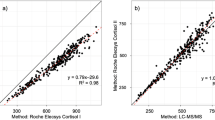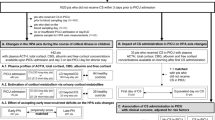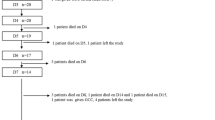Abstract
Purpose
Corticosteroid insufficiency may occur among critically ill patients, but the diagnosis remains controversial. Historically assessment of free cortisol (FC) by means of equilibrium dialysis (ED) has required large blood volumes and prolonged fractionation time preceding analysis. We hypothesized that temperature-controlled centrifugal ultrafiltration with chemiluminescence immunoassay (CU/CI) would provide real-time FC data that highly correlated with ED/radioimmunoassay (ED/RI) or liquid chromatography/mass spectrometry (LC/MS) techniques.
Methods
We quantified and correlated baseline and corticotropin-stimulated TC and FC by means of CU/CI, ED/RI, and LC/MS among healthy adults and 37 critically ill children.
Results
Among critically ill children, FC was three- to fivefold higher than the healthy adults at baseline and increased another five- to eightfold following corticotropin administration. While TC increased approximately twofold following corticotropin administration, FC increased on average more than eightfold. Serum FC per CU/CI highly correlated with FC per ED/RI or LC/MS, but results were available in a fraction of the time. Children failing to increase TC by >9.0 μg/dL (248 nM) following corticotropin demonstrated an appropriate FC increase. Nearly 50% of critically ill children exhibited FC <2.0 μg/dL (55 nM). Neither FC nor TC concentrations correlated significantly with measures of illness severity.
Conclusions
Quantification of FC utilizing CU/CI was fast (1–2 h) and results correlated highly with ED/RI or LC/MS methodologies. These data require validation with larger cohorts of healthy and critically ill children but indicate that real-time FC quantification is available to guide cortisol replacement therapy.

Similar content being viewed by others
References
Webster JI, Tonelli L, Sternberg EM (2002) Neuroendocrine regulation of immunity. Annu Rev Immunol 20:125–163
Chrousos GP (1995) The hypothalamic-pituitary-adrenal axis and immune-mediated inflammation. N Engl J Med 332:1351–1362
Bone RC (1996) Sir Isaac Newton, sepsis, SIRS, and CARS. Crit Care Med 24:1125–1128
Marik PE, Pastores SM, Annane D, Meduri GU, Sprung CL, Arlt W, Keh D, Briegel J, Beishuizen A, Dimopoulou I, Tsagarakis S, Singer M, Chrousos GP, Zaloga G, Bokhari F, Vogeser M (2008) Recommendations for the diagnosis and management of corticosteroid insufficiency in critically ill adult patients: consensus statements from an international task force by the American College of Critical Care Medicine. Crit Care Med 36:1937–1949
Annane D (2003) Time for a consensus definition of corticosteroid insufficiency in critically ill patients. Crit Care Med 31:1868–1869
Hamrahian AH, Oseni TS, Arafah BM (2004) Measurements of serum free cortisol in critically ill patients. N Engl J Med 350:1629–1638
Loriax L (2004) Glucocorticoid therapy in the intensive care unit. N Engl J Med 350:1601–1602
Beishuizen A, Thijs LG, Vermes I (2001) Patterns of corticosteroid-binding globulin and the free cortisol index during septic shock and multitrauma. Intensive Care Med 27:1584–1591
Ho JT, Al-Musalhi H, Chapman MJ, Quach T, Thomas PD, Bagley CJ, Lewis JG, Torpy DJ (2006) Septic shock and sepsis: a comparison of total and free plasma cortisol levels. J Clin Endocrinol Metab 91:105–114
Sprung CL, Annane D, Keh D, Moreno R, Singer M, Freivogel K, Weiss YG, Benbenishty J, Kalenka A, Forst H, Laterre PF, Reinhart K, Cuthbertson BH, Payen D, Briegel J (2008) Hydrocortisone therapy for patients with septic shock. N Engl J Med 358:111–124
Lentjes EG, Romijn F, Maassen RJ, de Graaf L, Gautier P, Moolenaar AJ (1993) Free cortisol in serum assayed by temperature-controlled ultrafiltration before fluorescence polarization immunoassay. Clin Chem 39:2518–2521
Hatherill M, Tibby SM, Hilliard T, Turner C, Murdoch IA (1999) Adrenal insufficiency in septic shock. Arch Dis Child 80:51–55
Goldstein B, Giroir B, Randolph A (2005) International Pediatric Sepsis Consensus Conference: definitions for sepsis and organ dysfunction in pediatrics. Pediatr Crit Care Med 6:2–8
Pollack MM, Patel KM, Ruttimann UE (1996) PRISM III: an updated pediatric risk of mortality score. Crit Care Med 24:743–752
Leteurtre S, Martinot A, Duhamel A, Gauvin F, Grandbastien B, Nam TV, Proulx F, Lacroix J, Leclerc F (1999) Development of a pediatric multiple organ dysfunction score: use of two strategies. Med Decis Making 19:399–410
Leteurtre S, Martinot A, Duhamel A, Proulx F, Grandbastien B, Cotting J, Gottesman R, Joffe A, Pfenninger J, Hubert P, Lacroix J, Leclerc F (2003) Validation of the Paediatric Logistic Organ Dysfunction (PELOD) score: prospective, observational, multicentre study. Lancet 362:192–197
Wernovsky G, Wypij D, Jonas RA, Mayer JE Jr, Hanley FL, Hickey PR, Walsh AZ, Chang AC, Castaneda AR, Newburger JW et al (1995) Postoperative course and hemodynamic profile after the arterial switch operation in neonates and infants. A comparison of low-flow cardiopulmonary bypass and circulatory arrest. Circulation 92:2226–2235
Skippen PW, Krahn GE (2005) Acute renal failure in children undergoing cardiopulmonary bypass. Crit Care Resusc 7:286–291
Bland JM, Altman DG (1999) Measuring agreement in method comparison studies. Stat Methods Med Res 8:135–160
Annane D, Maxime V, Ibrahim F, Alvarez JC, Abe E, Boudou P (2006) Diagnosis of adrenal insufficiency in severe sepsis and septic shock. Am J Respir Crit Care Med 174:1319–1326
Dellinger RP (2008) Steroid therapy of septic shock: the decision is in the eye of the beholder. Crit Care Med 36:1987–1989
Dellinger RP, Levy MM, Carlet JM, Bion J, Parker MM, Jaeschke R, Reinhart K, Angus DC, Brun-Buisson C, Beale R, Calandra T, Dhainaut JF, Gerlach H, Harvey M, Marini JJ, Marshall J, Ranieri M, Ramsay G, Sevransky J, Thompson BT, Townsend S, Vender JS, Zimmerman JL, Vincent JL (2008) Surviving Sepsis Campaign: international guidelines for management of severe sepsis and septic shock: 2008. Crit Care Med 36:296–327
Waterhouse R (1911) A case of suprarenal apoplexy. Lancet 1:577–578
Geiseler D, Ritter M (1983) On the validity of free hormone measurements. Anal Biochem 132:174–182
Waters NJ, Jones R, Williams G, Sohal B (2008) Validation of a rapid equilibrium dialysis approach for the measurement of plasma protein binding. J Pharm Sci 97:4586–4595
Janzen N, Sander S, Terhardt M, Peter M, Sander J (2008) Fast and direct quantification of adrenal steroids by tandem mass spectrometry in serum and dried blood spots. J Chromatogr B Analyt Technol Biomed Life Sci 861:117–122
Christ-Crain M, Jutla S, Widmer I, Couppis O, Konig C, Pargger H, Puder J, Edwards R, Muller B, Grossman AB (2007) Measurement of serum free cortisol shows discordant responsivity to stress and dynamic evaluation. J Clin Endocrinol Metab 92:1729–1735
Vogeser M, Mohnle P, Briegel J (2007) Free serum cortisol: quantification applying equilibrium dialysis or ultrafiltration and an automated immunoassay system. Clin Chem Lab Med 45:521–525
Patel RS, Shaw SR, Macintyre H, McGarry GW, Wallace AM (2004) Production of gender-specific morning salivary cortisol reference intervals using internationally accepted procedures. Clin Chem Lab Med 42:1424–1429
Dennesen P, van der Ven A, Vlasveld M, Lokker L, Ramsay G, Kessels A, van den Keijbus P, van Nieuw Amerongen A, Veerman E (2003) Inadequate salivary flow and poor oral mucosal status in intubated intensive care unit patients. Crit Care Med 31:781–786
Poomthavorn P, Lertbunrian R, Preutthipan A, Sriphrapradang A, Khlairit P, Mahachoklertwattana P (2009) Serum free cortisol index, free cortisol, and total cortisol in critically ill children. Intensive Care Med 35:1281–1285
Rosner W (1991) Plasma steroid-binding proteins. Endocrinol Metab Clin North Am 20:697–720
Riche FC, Boutron CM, Valleur P, Berton C, Laisne MJ, Launay JM, Chappuis P, Peynet J, Vicaut E, Payen D, Cholley BP (2007) Adrenal response in patients with septic shock of abdominal origin: relationship to survival. Intensive Care Med 33:1761–1766
Rady MY, Johnson DJ, Patel B, Larson J, Helmers R (2005) Cortisol levels and corticosteroid administration fail to predict mortality in critical illness: the confounding effects of organ dysfunction and sex. Arch Surg 140:661–668; discussion 669
Schroeder S, Wichers M, Klingmuller D, Hofer M, Lehmann LE, von Spiegel T, Hering R, Putensen C, Hoeft A, Stuber F (2001) The hypothalamic-pituitary-adrenal axis of patients with severe sepsis: altered response to corticotropin-releasing hormone. Crit Care Med 29:310–316
Soni A, Pepper GM, Wyrwinski PM, Ramirez NE, Simon R, Pina T, Gruenspan H, Vaca CE (1995) Adrenal insufficiency occurring during septic shock: incidence, outcome, and relationship to peripheral cytokine levels. Am J Med 98:266–271
Cooper MS, Stewart PM (2003) Corticosteroid insufficiency in acutely ill patients. N Engl J Med 348:727–734
Marik PE, Zaloga GP (2003) Adrenal insufficiency during septic shock. Crit Care Med 31:141–145
Annane D, Sebille V, Troche G, Raphael JC, Gajdos P, Bellissant E (2000) A 3-level prognostic classification in septic shock based on cortisol levels and cortisol response to corticotropin. JAMA 283:1038–1045
Pizarro CF, Troster EJ, Damiani D, Carcillo JA (2005) Absolute and relative adrenal insufficiency in children with septic shock. Crit Care Med 33:855–859
Casartelli CH, Garcia PC, Branco RG, Piva JP, Einloft PR, Tasker RC (2007) Adrenal response in children with septic shock. Intensive Care Med 33:1609–1613
van Woensel JB, Biezeveld MH, Alders AM, Eerenberg AJ, Endert E, Hack EC, von Rosenstiel IA, Kuijpers TW (2001) Adrenocorticotropic hormone and cortisol levels in relation to inflammatory response and disease severity in children with meningococcal disease. J Infect Dis 184:1532–1537
De Kleijn ED, Joosten KF, Van Rijn B, Westerterp M, De Groot R, Hokken-Koelega AC, Hazelzet JA (2002) Low serum cortisol in combination with high adrenocorticotrophic hormone concentrations are associated with poor outcome in children with severe meningococcal disease. Pediatr Infect Dis J 21:330–336
Joosten KF, de Kleijn ED, Westerterp M, de Hoog M, Eijck FC, Hop WCJ, Voort EV, Hazelzet JA, Hokken-Koelega AC (2000) Endocrine and metabolic responses in children with meningoccocal sepsis: striking differences between survivors and nonsurvivors. J Clin Endocrinol Metab 85:3746–3753
Riordan FA, Thomson AP, Ratcliffe JM, Sills JA, Diver MJ, Hart CA (1999) Admission cortisol and adrenocorticotrophic hormone levels in children with meningococcal disease: evidence of adrenal insufficiency? Crit Care Med 27:2257–2261
Onenli-Mungan N, Yildizdas D, Yapicioglu H, Topaloglu AK, Yuksel B, Ozer G (2004) Growth hormone and insulin-like growth factor 1 levels and their relation to survival in children with bacterial sepsis and septic shock. J Paediatr Child Health 40:221–226
Acknowledgments
Partial salary support for Zimmerman and Barker provided by U10 HD049945, Eunice Kennedy Shriver NIH/NICHD, Collaborative Pediatric Critical Care Research Network. This work was presented in abstract form at the Society of Critical Care Medicine, 37th Critical Care Congress, Honolulu, HI, 2/3/2008. Crit Care Med 2007;35(Suppl):A132 (abstract 483).
Author information
Authors and Affiliations
Corresponding author
Rights and permissions
About this article
Cite this article
Zimmerman, J.J., Barker, R.M. & Jack, R. Initial observations regarding free cortisol quantification logistics among critically ill children. Intensive Care Med 36, 1914–1922 (2010). https://doi.org/10.1007/s00134-010-2007-1
Received:
Accepted:
Published:
Issue Date:
DOI: https://doi.org/10.1007/s00134-010-2007-1




